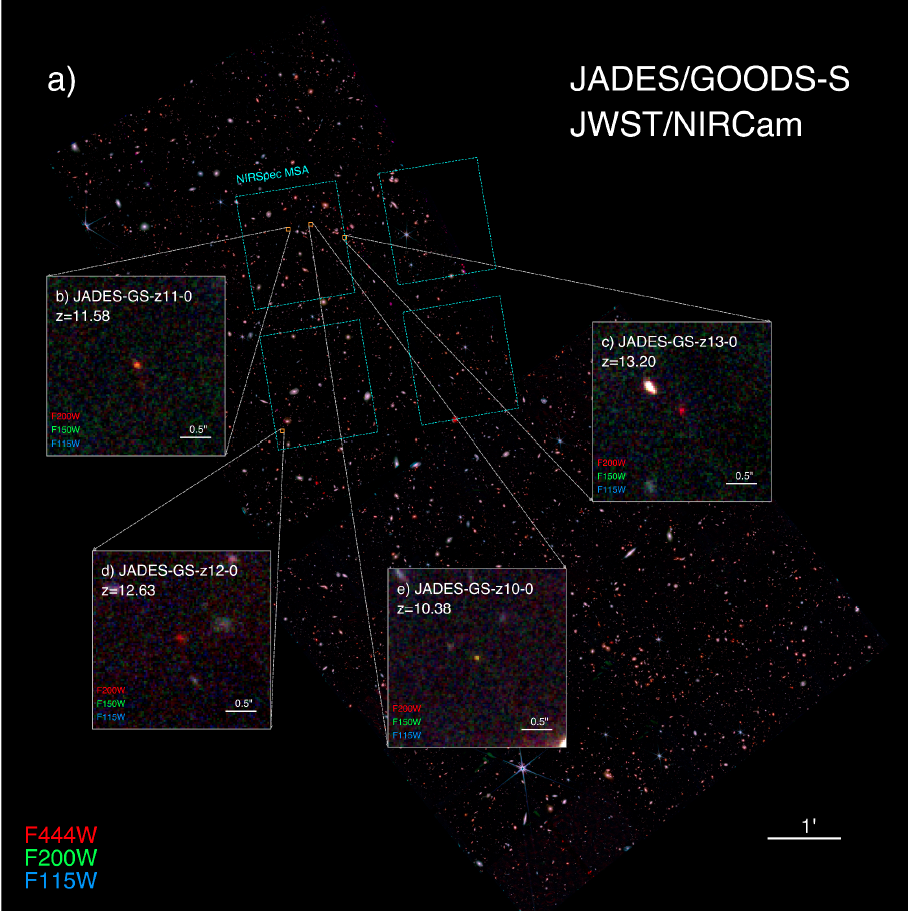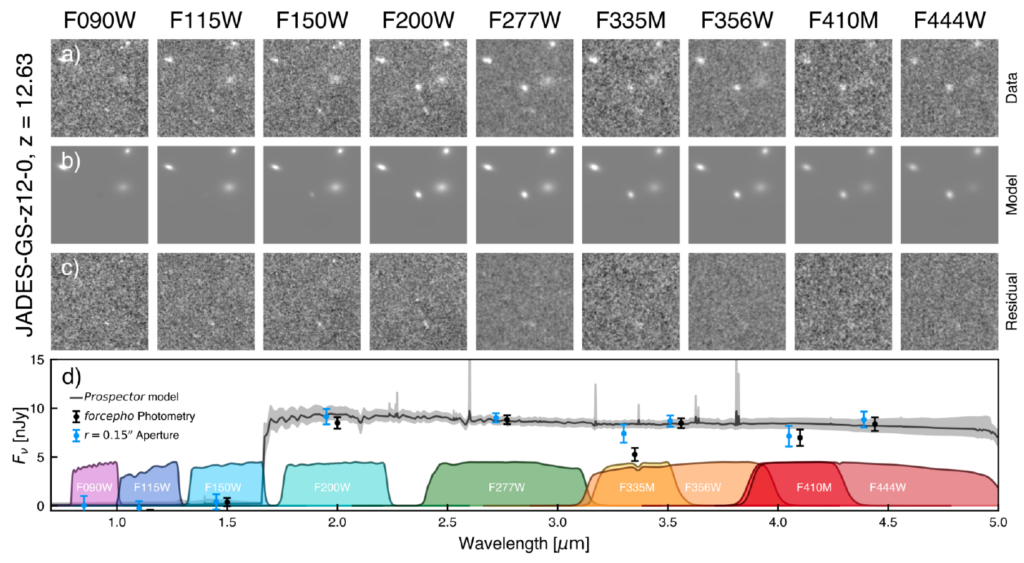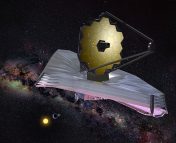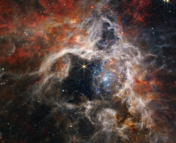Title: Discovery and properties of the earliest galaxies with confirmed distances
Authors: *B. E. Robertson, *S. Tacchella, B. D. Johnson, K. Hainline, L. Whitler, D. J. Eisenstein, R. Endsley, M. Rieke, D. P. Stark, S. Alberts, A. Dressler, E. Egami, R. Hausen, G. Rieke, I. Shivaei, C. C. Williams, C. N. A. Willmer, S. Arribas, N. Bonaventura, A. Bunker, A. J. Cameron, S. Carniani, S. Charlot, J. Chevallard, M. Curti, E. Curtis-Lake, F. D’Eugenio, P. Jakobsen, T. J. Looser, N. Lützgendorf, R. Maiolino, M. V. Maseda, T. Rawle, H.-W. Rix, R. Smit, H. Übler, C. Willott, J. Witstok, S. Baum, R. Bhatawdekar, K. Boyett, Z. Chen, A. de Graaff, M. Florian, J. M. Helton, R. E. Hviding, Z. Ji, N. Kumari, J. Lyu, E. Nelson, L. Sandles, A. Saxena, K. A. Suess, F. Sun, M. Topping, I. E. B. Wallace (* equal contribution)
First Author’s Institution: University of California, Santa Cruz
Status: Submitted to Nature [closed access]
The earliest galaxies were the first big structures to form in the Universe. They probably had a high rate of star formation and the intense radiation from these stars contributed to cosmic reionization. The light from these galaxies travels billions of lightyears to reach us, and in the process, gets redshifted due to the expansion of the Universe. Before the launch of the James Webb Space Telescope (JWST), the most distant galaxy was around redshift z=10, which means that light from this galaxy was emitted 13 billion years ago.
JWST breezed past these records as soon as scientists analyzed the first round of science observations. In today’s paper, the authors select and confirm four galaxies that all lie beyond redshift 10. Fig 1 shows their images and the spatial distribution. Now, the galaxy with the highest known redshift (and hence, the earliest formed) is now JADES-GS-z13-0 at redshift 13.20, 400 million years after the Big Bang. It was discovered by NIRCam imaging and confirmed with NIRSpec spectroscopy, showcasing the unprecedented ability of JWST.
Using the Lyman Break to find high-redshift galaxies

The earliest formed galaxies are the farthest away, (recall that light travels at a finite speed, hence looking further out means looking back in time). They are hard to find and their redshifts are even harder to confirm. Astronomers have used the Lyman break technique to find high redshift galaxies (see this astrobite for a detailed explanation). The Lyman break is a sharp jump in the spectrum of a galaxy. Hyrdrogen in the intergalactic medium absorbs light with wavelengths shorter than 912 Angstroms (0.09 micron) while allowing longer wavelengths to pass through, leaving this imprint on the spectrum. As the light travels to us, the expansion of the Universe redshifts the entire spectrum including the Lyman break. For a redshift z=10 galaxy, we would observe the Lyman break at a wavelength of 0.09*(1+z) ~ 1 micron. An example can be seen in Fig 2: the Lyman break has shifted to around 1.6 micron. This is in the infrared range, where thermal emission from Earth drowns out faint signals from high-redshift galaxies. Thus, JWST can see galaxies further than any telescope before.
In today’s paper, the JWST Advanced Deep Extragalactic Survey (JADES) team used NIRCam on JWST to image the well-studied GOODS-South field. This field includes the famous Hubble Ultra Deep Field but is 15 times larger. The team spent 10 days taking images with different filters and measured the brightness of galaxies in each filter (the wavelength coverage is shown as colored regions in the bottom panel of Fig 2.). Filters catching light below the Lyman break (F090W, F115W, F150W) show no sign of the galaxy because that light has been absorbed by the intergalactic medium between us and the galaxy, while the galaxy shows up in filters above F200W. Objects like this are promising candidates for high-redshift galaxies.

Seeing is believing
There are things other than the Lyman break that can make your galaxy drop out from a photometric filter. For example, the candidates identified this way can also be stars or nearby galaxies with a Balmer break at 4000 Angstroms. We need to see their spectra to confirm the Lyman break and securely measure the redshift. Taking spectra of faint sources is much harder than taking images. Imagine we receive a fixed amount of photons from the source. To take an image, we would collect all of them and add up the number; to take a spectra though, we need to spread out these photons and collect them in wavelength bins. Add on instrumental noise, emission from the sky, and limited dark time (~8-12 hours per night), taking spectra of high-redshift galaxies becomes infeasible from the ground. This is where JWST revolutionizes the field.
The galaxies in today’s paper are confirmed as high-redshift galaxies by NIRSpec, the workhorse Near-infrared spectrograph on JWST. NIRSpec has a microshutter array which can open tiny slits anywhere on the field. The team opened slits where they found the high-redshift galaxy candidates and stared at them for three days, totaling 28 hours of data collection. The detailed analysis of the resulting spectra is the topic of a companion paper, Spectroscopy of four metal-poor galaxies beyond redshift ten, also submitted to Nature. The Lyman break is clearly detected in the spectra. The spectra not only confirmed the four galaxies in this paper but also provided an accurate measurement of their redshifts: 13.20, 12.63, 11.58 and 10.38 (included in Fig 1).
Starburst
With a secure redshift in hand, the authors of today’s paper can pin down the physical properties of these extremely high redshift galaxies. The brightness in each filter carries information about the star-formation history and the composition of stars in these galaxies. This process is called Spectral Energy Distribution, or SED, modeling. SED modeling codes such as Prospector (used in this analysis and shown in panel d of Fig 2) take the observed brightness in each band and compare it to expectations from different stellar populations.
From the best match, the authors found that these high-redshift galaxies are forming stars at extremely high rates. Stars in these galaxies are young – ranging from 16 to 71 million years old. Their stellar mass is comparable to the Small Magellanic Cloud, but they are forming stars more than ten times faster. This star formation rate averaged over their size yields a star formation surface density that is comparable to the most vigorous starbursts in the local Universe. With such a high rate of star formation, more than half of the photons produced in these high redshift galaxies can eventually escape. This means that the galaxies in today’s paper could have contributed to the cosmic reionization process.
Future JADES observations will reach 750 hours of combined observing time and produce exquisite JWST imaging and spectroscopy of high-redshift galaxies. This is only the beginning of a new era where we will be able to see galaxy evolution from the redshift frontier throughout cosmic time. Get ready for more record-breaking discoveries from JWST!
Astrobite edited by Viraj Karambelkar
Featured image credit: JADES collaboration





Zili: Thank you for the interesting and informative (not to mention exciting) post!
If you have time, could you clear up a point of confusion for me?
Your article states:
“For a redshift z=10 galaxy, we would observe the Lyman break at a wavelength of 0.09*(1+z) ~ 1 micron”
So for the example of JADES-GS-z12-0 in figure 2, the Lyman break has shifted to about 1.6um, correct?
Working backwards to get the z value:
0.09(1+z) = 1.6
(1+z) = 1.6/0.09
z = (1.6/0.09)-1 ~ 16.8, as opposed the the paper’s value of 12.63.
Can you help me understand the error in my understanding?
Thank you!
Hi, it’s hard for a non-Phd to decypher what I’m looking for. I saw this on articles on phone and noticed 1320..
The Mayan (Tzolkin)Calendar is 13 tones and 20 day signs… Hence 13×20=260 days, each 13 combining with 1 of 20 each time each year.
I would be looking for galactic ratios, and other things..
Can anyone see any symmetry in this 1320 occurance with the 13-20 of the calendar?
Co-incidence maybe, but Maya made this calendar thousands of years ago, and it will exist for ..Infinity to guide us..
Can you look at it, and see if there are ratios or forms that show symmetry? Thanks
Thank you. This is exciting news.
All my best wishes!
Tom Mollo in Chicago
Z = 13.20
Could someone much smarter than me express this in terms of recessional velocity i.e. km/sec?
Thank you.
We know that the equation connecting the recession velocity to the redshift is given by:
z = v/c
so, z can not be larger than 1
So, how we can get a measured redshift value of the order of 13?
Thanks.